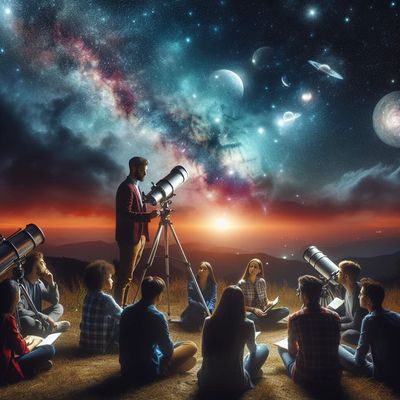Signed in as:
filler@godaddy.com
Signed in as:
filler@godaddy.com

This page shows a brief summary of what interesting things we can see in the sky this month.
A more detailed version of the 'What's Up' this month is available as a downloadable PDF document right at the bottom of this page.
As autumn settles in, we can now embrace the longer, darker nights—perfect for stargazing. The Summer Triangle has shifted to the western sky, while some deep-sky treasures like the Double Cluster and the Andromeda Galaxy shine high overhead. Keep an eye out for the Hyades and Pleiades, which will rise before midnight, and as the clock strikes twelve, the mighty Orion will start to make its grand entrance in the night sky.
The Sun
The Sun is currently very active.
Remember: to never look at the sun with a telescope, at worst you might blind yourself, at best you'll melt your telescope! If you are interested in Solar viewing, speak to our members, we have special equipment to help you! If you do not have a solar scope, you can watch using the Solar and Heliospheric Observatory (SOHO) or SDO.
The Moon
The phases of the Moon are as follows:
Visible before sunrise, low on the eastern horizon.
Highly visible as the ‘morning star’ before dawn with a magnitude of -4.5.
Not likely to be visible.
Rises after sunset and bright at mag -2.9.
Visible brighter at the beginning of the month, mag +0.5.
Visible all night, at mag +5.7.
Visible all night, magnitude +7.8.
Asteroids
No asteroids this month.
Comets
Comet C/2023 Tsuchinshan-ATLAS will be visible just after sunset towards the end of the month.
Meteors
The Draconids peak on the 8th-9th. The Orionids peak 21st-22nd.
Best seen between midnight and dawn.
Deep Sky
The darkest nights this month are from the 20th to 27th. This is the perfect time to view the Milky Way. Start in the West at Altair in Aquilla (it's the bright point of the Summer Triangle) and rise up into Sagitta, The Arrow. Between Gamma and Delta, look for open cluster M71. Continuing to the eastern sky, you have the M34 cluster, which can easily be seen through a telescope. Other observable clusters this month include, M36, M37 and M38.During the early hours sees the return of Orion to our skies, rising in the East, this allows for viewing of the Flame and Horsehead Nebulas, along with M42. These targets should be visible through binoculars or telescopes. For those Astrophotographers, the North American Nebula makes an excellent target for long periods of capturing data, as it is visible until the early hours.
Lots to see now that the nights are darker!
Television
The next episode of the Sky at Night is on Monday 7th October on BBC Four - Question Time Special at 22:00. The Sky at Night’s annual Question Time Special, where viewers get the opportunity to ask the questions they have always wanted answered about our universe.
Here are all the past episodes that are available to watch, in case you missed any: BBC4 The Sky At Night
Clear Skies !
The detailed version of What's Up this month is available below by clicking the link:
This website uses cookies. By continuing to use this site, you fully accept our use of cookies, and ALL the conditions set out on our Privacy Policy page. Privacy Policy

Thursday 17th October 2024 at 7pm:
COMET HUNT
Several members will be on Barr Beacon this evening around 7pm to try and observe comet C/2023 A3 Tsuchinshan-Atlas again. After observing, we will then be heading to the club to meet up with our members who are not observing.
The forecast is reasonable with clear patches from 7pm onwards so should hopefully be visible with cameras and binoculars. Also bring a warm coat to cut out the wind on Barr Beacon.
Regards
Walsall Astronomical Society